The Kate Weare Dance Company celebrates its tenth anniversary at New York’s BAM Fisher.
Before the second performance of the Kate Weare Company’s season at BAM Fisher, Weare addressed the audience. The season marked her company’s tenth anniversary, and she wanted to praise the dancers. She mentioned their courage, their daring, and more. They were, she said, her heroes.
They’re my heroes too. Weare’s choreography requires superb timing; if a dancer moves one split-second ahead or behind his or her partner, someone could get hurt. But Weare doesn’t traffic with virtuosity or risk for their own sakes. Instead, she has created an extraordinary movement language that enlarges and makes luminous the shifting emotions and drives that keep our relationships falling in and out of balance. You see two people (or more) embody such ideas as cooperate, console, punish, try to understand, fight, parry, evade, make love, rest. Watching them, your breathing quickens.
Although Weare’s dances share certain themes and stylistic choices, each has a distinctive look. I first saw her work in 2006, on a program at the former Dance Theater Workshop that she shared with Ivy Baldwin. The piece was Wet Road, for two pairs of dancers, plus Weare herself, as a kind of onlooker and stage manager. Her source for the choreography was the tango, with its pounces and pauses, its intimacy and erotic heat, its games with aggression and submission.
A new duet and one of the three that Weare chose to reprise for the BAM Fisher program reveal how she continued to explore and transform aspects of the tango—including such moves as a person flashing, with the speed of a knife thrust, one straight leg between the legs of his/her partner; moving into a tight embrace and spinning out of it. The pauses that stud the rapid, complicated maneuvers add to the heat of the dancing, to its smolder.
Drop Down (2007), the oldest piece on the program, was performed at BAM Fisher by guest artists Joseph Hernandez and Natasha Adorlee Johnson of San Francisco’s Oberlin Dance Collective. As in all Weare’s dances, they wear costumes that allude to street attire (in this case, by Astrid Angarita). To an original score by Katie Down and Alex Davis, they prowl the space like animals in heat, sizing each other up. The duet begins with Johnson crouching down to draw a circle on the floor in dappled pool of light (all the fine lighting for the program is by Mike Faba), while Hernandez stands still beside her; it ends with the beginning of a kiss.
The heat generated between them is formidably erotic. When they assume a ballroom-dance hold, they seem to be trying to melt into each other or set up a friction that could any moment burst into flame. But this is no dance floor they’re occupying. At one point, she’s lying down, grasping his ankles, so that, as he takes big steps here and there, she rolls and twists; it’s hard to tell who’s in charge. And while she sits and watches him dance, the whiplash speed with which he launches himself into a spin conveys not only furious energy but the intentness of a male bird in his courting dance.
Volver (2015) is a duet for two men: T.J. Spaur and Douglas Gillespie (who has been a member of Weare’s company almost from its inception). Their music is a song, “Volver a los diecisiete,” by the Chilean Violeta Parra, whose high, husky voice, accompanied by guitar, sings of love and memories. The first lines, roughly translated, say, “Going back to being seventeen again after living for a century is like deciphering signs without sufficient knowledge.” Maybe that’s why Spaur and Gillespie begin sitting on side-by-side chairs and remove their shoes before they take to the dance floor. The act, I think, is not ironic, but symbolic of a return to another state. This is a tango without antagonism. The two men can lift each other off the floor, but spend much of the time in ballroom-dance position. For a long time, they never lose physical contact and their partnership is egalitarian. At times, they seem to be listening to each other’s bodies. Something—perhaps a hint of innocence despite their strength—made me write “childlike” in my program.
The other two duets are excerpted from longer works—one from Bridge of Sighs (2008) and one from Bright Land (2010), and both are performed by Gillespie and Leslie Kraus. Kraus has been in every piece of Weare’s that I’ve seen, and her onstage partnership with Gillespie is a thrilling one. In the earlier Bridge of Sighs, although there is an original score by One Ring Zero (Michael Hearst and Joshua Camp), the dancers create another kind of music by slapping each other’s bodies. They enter in silence from opposite sides of the space like two contenders and—whap!—Kraus hits Gillespie’s chest. The interplay of sounds and silences throughout their duet is almost as complex as the ingenious, almost alarming shiftings and tanglings of the dancers’ limbs and bodies. You wonder how they can negotiate these maneuvers while using each other as percussion instruments and parrying blows—especially given the speed at which they move.
Their pauses tell us a lot. They consider the effects of their actions, whether or not these are potentially aggressive. You imagine each thinking, “If I do this to you, how are you going to respond?” And, there are enough tender moments to show that this is a relationship worth fighting for.
The music for the terrific Bright Land (2010) is from the eponymous album by The Crooked Jades (in the case of this excerpted duet: “Waking City Shining” and “Pearl Bryan”). When I first saw the piece at the Joyce five years ago, the whole innovative, five-person bluegrass band was onstage too; at BAM Fisher, Kraus and Gillespie dance to a recording. Neither song is a joyous one (in “Pearl Bryan,” which refers to a 19th-century murder, the line “Tell me where’s her head” drops into the twanging guitar plaint), and although “Waking City Shining” expresses spiritual yearnings, it begins with “I’m so tired; sing me to sleep.” There’s no severe grappling in this, but a tender exploration of a relationship, ranging from Gillespie putting a hand on Kraus’s belly or carrying her in his arms, to her perching on his thighs. You’re never sure how the two arrive at new positions; counterbalances seem to make these effortless. Always, you feel the erotic heat between them and the questions hovering.
At one point, as the guitar strikes up “Pearl Bryan,” Gillespie crawls, led by Kraus’s hand on his neck (in the program Weare writes that the Crooked Jades added the traditional words about decapitation after they saw the dance in progress). But the Bright Land duet ends with a shock. The two performers are sitting on the floor facing each other, she astride his legs, and she butts him sharply in the chest four times; after each blow, he leans a little further back; in the end, he’s lying flat. Then the lights go out.
The second half of the BAM Fisher program premiered a trio, Unstruck, which I had seen at an earlier showing. It features Spaur, Nicole Diaz, and Julian De Leon (this is Diaz’s second season with the company and De Leon’s first). The score, by Curtis MacDonald (heard on tape at these performances) is for clarinet, tenor and alto saxophones, and contrabass, plus other sounds, and is notable, in part, for its subtle use of silence and a kind of spareness, which, given the nature of the instruments, is remarkable.
As Unstruck begins, Diaz is standing beside De Leon, arching far back, her chest to the ceiling. As she slowly revolves, maintaining that position, De Leon begins moving sinuously, his body expanding here, contracting there, constantly shifting its shape. Diaz touches a hand to his shoulder. To his knee. He keeps undulating as they travel across the space. She pauses, one leg stretched in front of her on the floor; he circles her several times, each time stepping over that leg. He doesn’t look at the obstacle, but senses it. Spaur enters and stops De Leon, who slowly collapses against him.
There is, throughout the dance, a feeling of magnetism—of people drawn together reasons not completely known to one another. In passing, I wonder about the title. It suggests a musical instrument waiting to be played, a kind of readiness for something that is yet to happen. When one of the performers stands on one leg with the other lifted, bent at the knee, you think of what might make that foot touch the ground and propel its owner forward or guarantee equilibrium.
They are almost always aware of one another. De Leon watches while, to rasping sounds, Diaz caresses Spaur; when a new deep sound enters, she arches back again. This time, Spaur bends forward over her, imitating the shape of her curve; she edges out from under that human ceiling. A few minutes later, while they’re gently manipulating each other, he forcefully bends her back again.
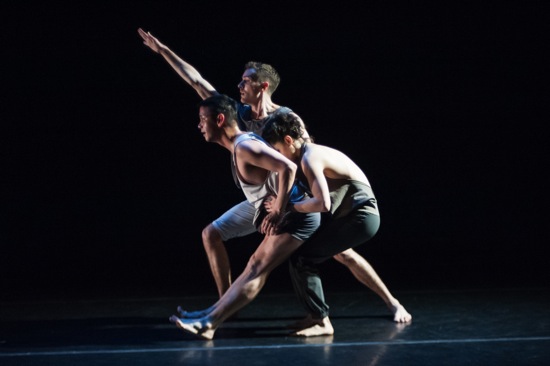
(L to R): Julian De Leon, T.J. Spaur, and Nicole Diaz in Kate Weare’s Unstruck. Photo: Keira Heu-Jwyn Chang
Although the three are occasionally alone, trying out different movements, two often collaborate to assist one, and there’s a longish section in which they seem to be playing a game or attempting a joint task. They line up, shoulder to shoulder, facing stage left and walk that direction, toward the lights that Faba has beamed from there. Occasionally, one or two break away, dancing out a tiny rebellion, and then return to the line. Are they gradually advancing toward the lights? No. Suddenly they back up, still in their line, behind their original position and start walking again. Regrouping becomes a pattern, with the music intermittently changing their landscape.
In the end, the two men slowly pace in a circle around Diaz, while she revolves, getting closer to the floor as she does so. In the end, she is again arching back, this time alone. The sky could fall.
Unstruck doesn’t have the intense intimacy of the duets. These three wonderfully alert and sensitive dancers project the image of collaborators trying out configurations that will solve problems or ease their minds. As in all Weare’s dances, their relation to their own bodies and the surrounding space is a sensual one, in which a gesture is alive to the space it displaces and to the others who inhabit it with them.
In her opening speech the night I attended, Weare, in speaking of the dancers’ heroism, made special mention of Kraus and Gillespie. He is now also serving as the company’s rehearsal director and assistant to Weare on choreographic commissions elsewhere. (One of the latter jobs involved the mob of Juilliard students, class of 2016, for whom Weare created Nightlight this past year; alas, I missed it in October, and the excerpt was shown at BAM Fisher only at two performances I couldn’t attend.)
In the nine years that I’ve seen Kraus perform, she is always brilliant—alive to the meat of every movement, sensitive as to how she might devour it or lick at its edges. Now she is taking a leave of absence from the company to work on other projects. I wish her well. I remember her last year in Weare’s Dark Lark, dancing with a large, unreal butterfly on her wrist. Of the two, she seemed the most ready to fly.

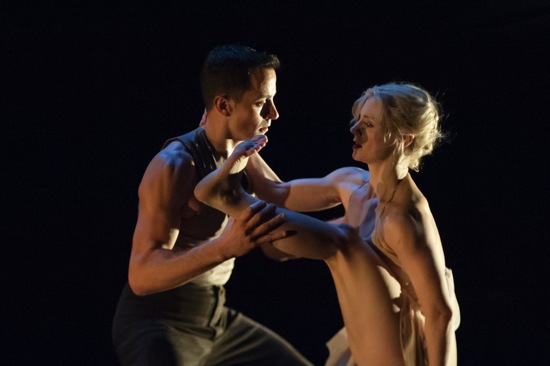
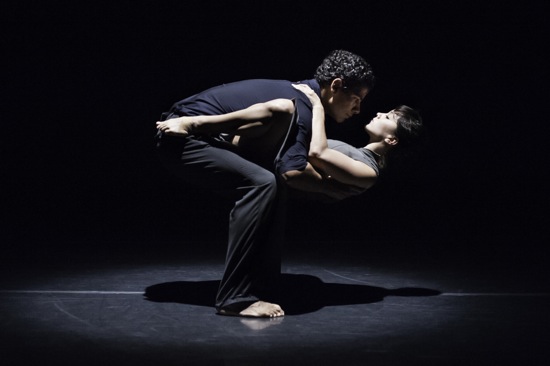
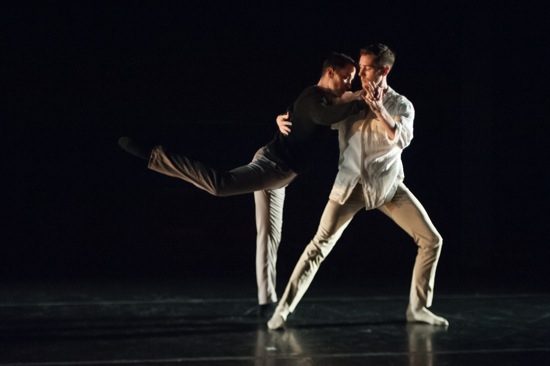
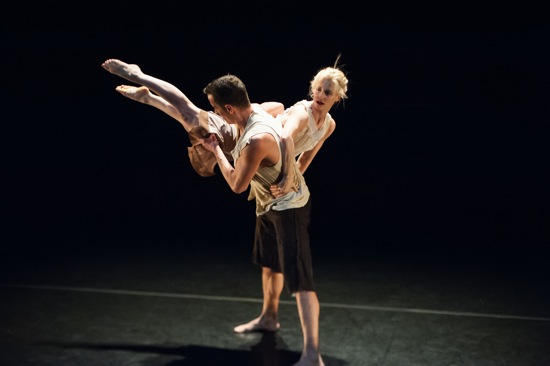
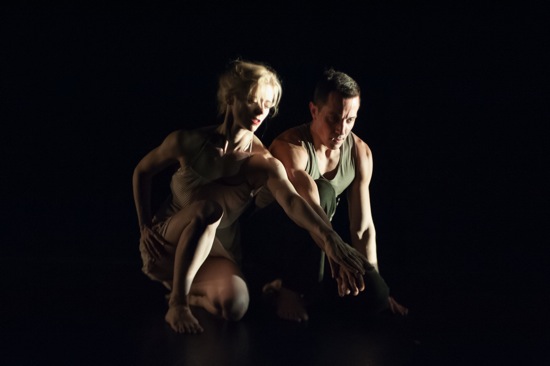
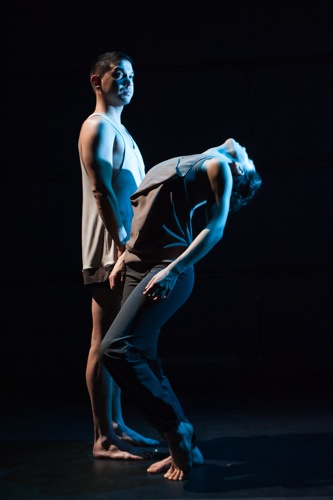
I knew I should have gone to this . I was with Jodee Nimerichter the gala night and since she only got one ticket, I’d have splurged if I thought I could get in. The dancing seems great and innovative.
JG